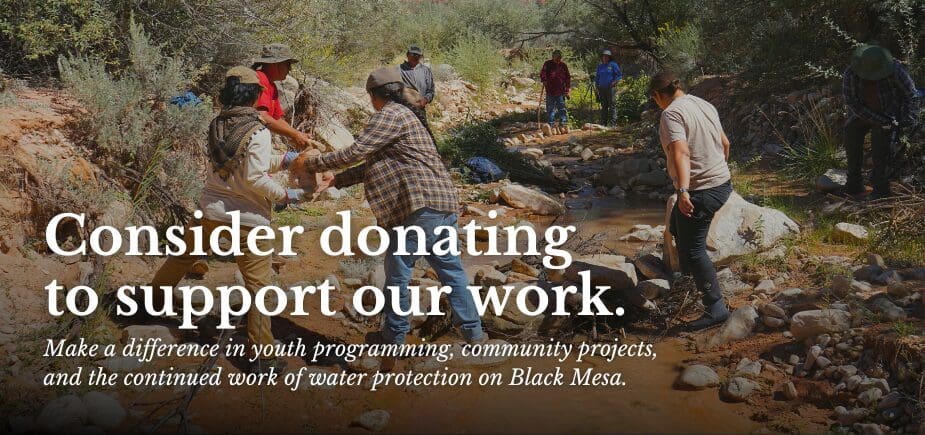Monitoring Day 2025: Tsiyi’ Tó Watershed

BLACK MESA – During some of the wettest consecutive days of 2025 so far, the Tó Nizhóní Ání watershed crew set out to monitor the progression of restoration in the Tsiyi’ Tó Pilot Project Site. Periods of consistent rainfall led to flowing washes and streams, creating the perfect conditions to observe moisture infiltration and take note of where pools of water are forming. Roads became muddy and rutted, but the crew was determined to get out there to see for themselves. University of Pennsylvania and Brophy College Preparatory students joined the TNA Watershed crew to see how structures have held up during the most significant rainfall of the year. Learn more about the Tsiyi’ Tó Pilot Project by visiting our landing page at tonizhoniani.org/watershed.
Tsiyi’ Tó translates to “within the wooded area there is water”, which references the spring that is located at the headwater of the Tsiyi’ Tó wash.
On Friday, October 10th, the TNA watershed crew was accompanied by several University of Pennsylvania Weitzman School of Design’s Landscape Architecture students. The UPenn students planned to be in the area visiting the Hopi Reservation when they connected with our watershed lead Andrew for this site visit. The concerns for wash outs rerouted the convoy to an old road crossing of the Tsiyi’ Tó tributary. Vehicles tip-toed through and traveled under cloudy skies to make it as far as the large sub-tributary crossing.
The last recent reading was in September, and with this visit, the Rain Gauge total at the southern end of the Tsiyi’ Tó watershed measured 1.32 Inches of rainfall. It was a short hike on foot from the Rain Gauge Location, leading to the cross-vane weir. The stream is redirected into a narrower channel, allowing the high flow of the wash to be controlled. The sediment is building up at the upstream end of the weir, which aids in building back the old road crossing. Grass and vegetation is growing along areas of branches placed in the stripped rangeland caused by overgrazing.
The team hiked downstream to the meadow where plug and spread structures were first built. The structures did not hold up to flooding which lifted the logs out of place. Most upstream structures experienced the worst damage, with undercut logs and dislodged rocks.
On Monday, October 13th, students and staff from Brophy College Prep came to revisit the structures they have built a year prior in the pilot project. Brophy College Prep is a big advocate and supporter of Tó Nizhóní Ání in our restoration efforts, along with Apache Stronghold in Protecting Oak Flats in central and southern Arizona.
0.93 Inches of rain fell since the last visit on Friday, October 10th, which is a significant amount considering how dry the summer has been barely one inch over monsoon season.
Building rock rundowns in a riprap style created similar results to an adjacent Navajo Bowl, but the leading edge of the rangeland should mate with the rock structure to prevent further downcutting. After walking through the meadow where last year’s one rock dams were placed, walking through the entire system revealed that more structures needed to be built upstream. Three one rock dams were built in a “bookstack” style to increase strength. The rains held off for the day as the group walked through to other examples of log plugs.
The last site displayed the effectiveness of log sills installed with rocks to retain moisture, hold back sediment, and spread the width of the stream to rewet the landscape.
There was much to learn from those last couple of days on the watershed with moisture on the land. The TNA Watershed Crew will continue to monitor and make refinements to our designs to further implement new projects in the Oraibi Wash watershed. Tó Nizhóní Ání would like to thank the Weitzman School of Design for stopping by and the Brophy College Preparatory students for lending a head. Our organization appreciates the helping hands and opportunities where we can all learn and grow.
Learn more about our watershed restoration efforts by visiting our landing page at tonizhoiani.org/watershed.










